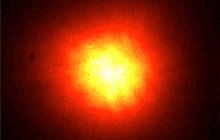CRIRES (pre-upgrade)
CRyogenic high-resolution InfraRed Echelle Spectrograph
 The pre-upgrade CRyogenic high-resolution InfraRed Echelle Spectrograph (CRIRES) was looked after by Jonathan Smoker, and is located on the side of Unit Telescope 1 (UT1, Antu) of the Very Large Telescope (VLT) based at the Paranal Observatory. The instrument consisted of both a spectrograph to split the light into its separate components for individual analysis, and the MACAO (Multi-Applications Curvature Adaptive Optics) adaptive optics system. Using a reference star, MACAO measured the distortions of the image caused by the turbulence of the atmosphere, computes the corrections needed, and applies them to a small deformable mirror. This was done many times per second resulting in much sharper images, as shown here with star HIC 59206 (left side is without MACAO, right side is with). This ensured that most of the light from a star can be fed into the very small entrance slit on the spectrograph.
The pre-upgrade CRyogenic high-resolution InfraRed Echelle Spectrograph (CRIRES) was looked after by Jonathan Smoker, and is located on the side of Unit Telescope 1 (UT1, Antu) of the Very Large Telescope (VLT) based at the Paranal Observatory. The instrument consisted of both a spectrograph to split the light into its separate components for individual analysis, and the MACAO (Multi-Applications Curvature Adaptive Optics) adaptive optics system. Using a reference star, MACAO measured the distortions of the image caused by the turbulence of the atmosphere, computes the corrections needed, and applies them to a small deformable mirror. This was done many times per second resulting in much sharper images, as shown here with star HIC 59206 (left side is without MACAO, right side is with). This ensured that most of the light from a star can be fed into the very small entrance slit on the spectrograph.
The pre-upgrade CRIRES was a high resolution echelle spectrograph, similar to UVES, where the incoming light was split very finely into its separate colours so that objects can be observed in great detail over a specific wavelength range. Observations with the pre-upgrade CRIRES were carried out in the infrared, which means looking at light of wavelengths 1 to 5 μm (1 μm is one millionth of a metre) — about 2–10 times longer than visible light. This particular wavelength range made the pre-upgrade CRIRES ideal for studying the dustier side of space. “It allows astronomers to observe molecular gas in Solar System objects and protoplanetary discs [a dense disc of gas surrounding a newly born star], to look for signatures of radial velocity in stars and exoplanet atmospheres [information that tells us how they are moving], and determine exactly what chemicals an observed star is made up of,” says Jonathan.
 CRIRES was the last of the first generation instruments to have been installed on the VLT — that is, the complement of instruments foreseen at the construction of the telescope. With CRIRES, the VLT received all the tools it needed to study any astronomical object at all wavelengths and resolution. The second generation instruments are being deployed to tackle specific questions uncovered with the first generation instruments, using the technological advances that have accumulated in the meantime.
CRIRES was the last of the first generation instruments to have been installed on the VLT — that is, the complement of instruments foreseen at the construction of the telescope. With CRIRES, the VLT received all the tools it needed to study any astronomical object at all wavelengths and resolution. The second generation instruments are being deployed to tackle specific questions uncovered with the first generation instruments, using the technological advances that have accumulated in the meantime.
The CRIRES upgrade project increased the wavelength range that is covered simultaneously by a factor of ten. In addition, a new detector replaced the existing one, a new spectropolarimetric unit was added and the calibration system was enhanced. The upgraded CRIRES saw first light in February 2021.
Science highlights with CRIRES
- Length of exoplanet day measured for first time (eso1414)
- CRIRES was used to create the first weather map for the nearest brown dwarf to Earth. (eso1404)
- Probe the atmosphere of exoplanet Tau Boo b. (eso1227)
- Astronomers using CRIRES found the first superstorm on an exoplanet, HD209458 b; they could also measure the planet’s mass. (eso1026)
- Triton, one of Neptune’s satellites, was observed with CRIRES, showing the effects of the seasons on its atmosphere. (eso1015)
- Observations with CRIRES showed that the atmosphere of Pluto is hotter and more methane-rich than previously thought. (eso0908)
|
The spectrum of star HR7235, straight from CRIRES. The infrared light from the star was strongly dispersed by the spectrograph, spreading its wavelnghts, or colours, from 2.89 μm to 2.97 μm (left to right) on the four detectors, that recorded the intensity of the light. The vertical lines correspond to features in the atmosphere, absorbing the light at specific colours. The images are peppered with many “hot pixels”, defects of the detectors that are removed by combining several spectra. |
CRIRES (pre-upgrade)The authoritative technical specifications as offered for astronomical observations are available from the Science Operation page.
|

